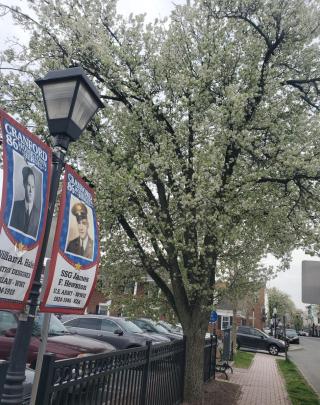Callery Pear

April 2024 Tree of the Month: Callery Pear
This month’s tree—the Callery Pear (Pyrus calleryana, also known by its cultivar name, “Bradford” Pear)—is a bit of a tricky one. Seen as a harbinger of spring, the Callery Pear is frequently one of the first trees we see in bloom, particularly in Downtown Cranford, where the street trees are nearly all this type. You will likely see (and smell) the white blossoms sometime this month as you walk around the downtown area.
While many find it beautiful and it has been part of our community for decades, it is problematic for several reasons. Why would the Shade Tree Commission dedicate a month to such a tree? Our aim is to educate the community about the danger it poses and to discuss ways of minimizing the harm.
Native to Vietnam and China, the Callery Pear was introduced in the United States in the early 1900s and gained widespread popularity in the 1960s. This fast-growing and purportedly sterile tree had many attractive features: beautiful white spring flowers and striking fall foliage, insect- and deer-resistance, and tolerance of various soils and moisture levels--irresistible qualities for an ornamental tree, particularly in an urban setting!
Unfortunately, these introduced trees began hybridizing with our native pear trees and, in the process, started producing fruit, which has created an environmental threat. As birds eat the fruits in the fall and winter, their droppings seed new trees in our parks, roadsides, and wild areas. Callery Pears bloom and leaf out earlier than North America’s native trees and sucker prodigiously. As a result, they often form dense homogeneous stands that crowd out everything else: native trees and understory plants cannot grow, and native fauna cannot find the food they need to survive and thrive. Even worse, these hybrids frequently have large thorns, which can damage equipment and harm livestock. Callery Pears are also host to fire blight, a bacterial disease that can kill native pear and apple trees and destroy an entire orchard in a single season.
Callery Pears have been found growing outside of cultivation in 25 states. These trees are such a problem that their sale has been banned in Ohio, Pennsylvania, and South Carolina (similar legislation is pending in New Jersey). In many other states, including Indiana, Kansas, Minnesota, Missouri, and Oklahoma, homeowners are discouraged from planting this species.
The environmental threat is just one reason to replace Callery Pear trees. First, the flowers are stinky! Comparisons to rotting fish are perhaps the kindest way to describe it. Other problems that make it unsuitable as a street tree or a specimen in the home landscape include its short life (often less than 25 years), and its weak wood and branch structure that make it prone to wind and ice damage.
As of the 2016 Township Tree Survey, Cranford had 409 Callery Pear trees on public property. The Shade Tree Commission intends to replace these trees as time and budget allow. We ask that if you have one of these trees on your private property, you consider removing it and replacing it with a native tree, including:
Native Trees:
- Serviceberry (Amelanchier species) – This small native tree has four-season interest, including delicate white flowers in early spring (similar to the Callery Pear), beautiful fall color, and fruit for the birds in the winter.
- Redbud (Cercis species, Cercis canadensis f. alba for white flowers) – Blooming on bare branches in early spring, most varieties have pink to magenta flowers, but there is also a white-flowering version of the Eastern redbud that will create a dramatic early spring show.
- Dogwood (Cornus florida) – This tree has spectacular spring blooms that are of special value to endangered native bees and support predatory insects (which in turn will reduce the need for mosquito spraying).
- Crabapple (Malus coronaria, M. fusca, or M. ioensis) – White to red flowers bloom in late April to early May, with edible fruits that are important food for many bird and pollinator species.
- Hawthorn (Crataegus coccinea) – White blooms emerge in late spring to early summer, with bright red fruits that persist into winter (if the birds don’t eat them all first!).
Each of these native trees will be featured in a future Tree of the Month discussion, so please come back to read more. Tree of the Month is also featured on our Township newsletter--please subscribe.
